World of Warcraft Movies
"I've like known people and stuff that have had like … y'know, like … like jobs and stuff like that. They wake up in the morning and they watch like CNN replays and stuff. I just don't really like that cause I think that's kinda fake, right? Like on CNN it's kinda like what the journalist thought happened, right? You watch a replay on CnCreplays and that's like what really happened, right?"
- Jeremy, in “Pure Pwnage,” Episode 1"With the advent of World of Warcraft, the internet has been flooded with movies made using the game."
- An Australian teenager on the Oz Chronicles blog (11 Sept. 2005)
Players of competitive, multiplayer games have proven to be the ultimate media fans. They are certainly “consumers who also produce” and “spectators who also participate.” [2] The connection of machinima to 3-D first-person shooter (FPS) games or of the replay scene to real-time strategy (RTS) games provide two important examples. While it is not customary to think of World of Warcraft as a competitive game, the cultural economy of the Warcraft series of RTS games has carried forward to WoW movies, particularly in the production of gameplay and PvP (player vs. player) movies. [2a] As I have argued elsewhere, Warcraft became the basis for a virtual community of players and fans built on the foundation of competitive play as a mode of performance. E-sports fans are spectators who play the game. This important distinction vis-à-vis, say, the majority of professional sports fans helps to explain the crucial role that the sharing of recorded replays of completed games has played as a media object in these communities. In a game that separates players from spectators, a non-player is not interested in watching a replay lacking the dramatic tension of an unknown outcome; players and coaches, on the other hand, watch them incessantly as a means for bringing detached analysis to bear on the improvement of their own skills and strategies.
The role of replays has been recognized throughout the development history of strategy and first-person shooter games, beginning with Dani Bunten Berry’s Modem Wars (1988). It included a feature that allowed players to store data from which replays or “game film,” as she called it, could be recorded and shared. Berry was amazed at "how people used this opportunity the game films offered to rationalize their loss and to create stories out of the intense and ephemeral experience of the battle.” Game film was included in both Command HQ (1990) and Global Conquest (1992). [3] Berry conceived of real-time gameplay as competitive player performance and clearly recognized the potential for building spectatorship around play-based narratives. By the mid-1990s, competition in computer games meant networked play, first via peer-to-peer Local Area Network connections as in DOOM, then client-server technology and the Internet. By 1995, support for networked, competitive games was snowballing.
So it was with Warcraft II and III. Network support made it possible to play with others and to watch others play. As Berry's vision of turning strategy gaming into a space for spectatorship and performance had predicted, players documented their prowess by recording movies for other players. Demo movies, spectator modes, machinima and game-based reputations of "worthy gamers" (id Software) were quickly associated with first-person action games such as DOOM (1993) and Quake (1996). [4] The publication of Warcraft II: Tides of Darkness and Command & Conquer within months of each other in 1994 fueled similar impulses. The growth of virtual communities of RTS players was served by matching services such as Kali that spoofed LAN connections over the Internet and Blizzard’s licensed of Warcraft to commercial networks such as TEN (Totel Entertainment Network), Mpath and Engage Games Online.
The growth of the Warcraft player community accelerated with the release of Warcraft III: Reign of Chaos in 2002. The gaming press devoted much attention to issues ranging from its 3-D environment and camera control to new in-game races and a "real-time roleplaying" element, but K. Tam, the editor of an FAQ devoted to Warcraft II, summarized what the player community probably expected: "Of course the most famous and most played part will be the multiplayer function." (Tam, 2003) Competition, rather than the story-driven single-player game, became the basis for player discussion, commentary, and performance. In Warcraft III, built-in spectator modes and replay capture, websites for distributing replays and VODs, reports and interviews from tournaments such as the World Cyber Games, and shoutcast commentaries of games fostered a player-spectator relationship around competitive game performance. Player, replay, game news, and replay sites proliferated, building a huge community database of multiplayer tips, star players, advice on “micro” (micro-management of units) and “strats” (strategies), fee-based play training, and reports of league or championship competitions. Berry had predicted that game replay movies would make legends out of performances; Tam’s Warcraft III FAQ specified how replays made reputations: "You can transfer your replay files, so you can trade them with other players. This can also be useful in distributing champion or particularly skilled player's games, or to catch cheaters as well." [5]
As the very existence of a game called World of Warcraft suggests, the story world in which the Warcraft series takes place has been important to its players. And yet, in contrast to the emergence of machinima from the demo movies, recams, and speedruns of first-person shooters, real-time strategy games have produced relatively few game-based movies. [6] Machinima sites such as machinima.com and the Machinima Archives offer not one single movie based on Warcraft III, for example. It would be lovely to speculate about the differences in cultures of game modification, technology, character identification, and visual perspective that have separated RTS games from other genres as platforms for game-based movies. But my topic today is the emergence of MMO-based movie-making in World of Warcraft and their relationship to the replay culture of Warcraft III and other RTS games. We will see that the initial impulse behind these projects owes as much to this culture as it does to the established tradition of machinima.
Promotional videos and “sneak peeks” based on The World of Warcraft had been prepared for the Electronic Entertainment Exposition and distributed via the web since 2002. However, it takes players to make movie files based on authentic game play. The first sites to distribute player-created movies launched while the game was still in its beta release. Warcraftmovies.com, the best known of these sites, was in operation by early October, 2004. Its avowed purpose was to offer "every single World of Warcraft movie that has been released." To put this date into perspective, consider that the first "stress test" of this game had occurred but a month earlier; the release of an open beta version of the game would not occur until the end of October. These events made possible the growth of a significant player community before the first official launch of the game in the United States, but even so, the movie site launched as the early expansion of this community was only just underway. The moderator of the site, located in Sweden, had himself not yet acquired a beta account.
Despite these limitations, on October 9th Warcraftmovies.com offered 59 movies with an average run-time of over 20 minutes and average file-size of 134MB; nearly 22000 downloads were recorded in just over a week after opening, well over 2000 per day. [7] This first batch of movies could be browsed via categories derived primarily from types of play and players: character class and category (PvP, PvE, and "other") in the former case, and language and geographic location in the latter. The firm emphasis on gameplay reveals much about the origins of WoW movies. While the game was still in beta, before it had become massively successful, much of the curiosity and anticipation concerning World of Warcraft came from the already established virtual communities created around Blizzard's competitive RTS titles, particularly Warcraft III. Moreover, these players were comfortable with leaving the storytelling and to Blizzard and situating it in the realm of promotional motives and the single-player campaign format perfected in Starcraft and the Warcraft series. [8]
By mid-September 2005, Warcraftmovies.com had gathered together roughly 3,500 WoW movies, about 250GB and over 400 hours of content; other sites such as IGN’s World of Warcraft Vault, XFire, and Fileplanet offered hundreds of movies. A specific interplay of technical mastery, gameplay, and storytelling such as was characteristic of early Quake movies is not particularly evident in this huge collection of projects. The thousands of WoW movies offered today on Warcraftmovies.com has been divided according to categories that reflect the separation of audience interests. This website claims to have supported about 18 million downloads in its first year of existence, an average of nearly 52,000 per day. Even with the vast expansion of the audience for these movies, about 30 percent are in the PvP category, with PvE and instance runs following distantly in popularity. Less than 10 percent have been put in the category of “story-line” movies, that is, attempts to present linear narratives through the recording and editing of in-game performances roughly akin to machinima. Related diversions from game replays include dance movies and music videos set to WoW footage, and the ubiquitous “other” category with documentation of in-game activities such as the “naked gnome” protest of 29 January 2005. What was hot, according to the website? A PvP movie devoted to the rogue class that, despite being a 352MB file download, is attracting nearly 10,000 downloads per day, almost 200, 000 in all since first being added to the collection. [9] Yet the “What’s Hot” list as of 15 September 2005 included examples from nearly every other format of movie in the classification scheme: PvP, PvE, Instances, Story-Line, and so on, an indication of the diversity of WoW-based movies and of the community’s interests both as spectators and players. It is time to look more closely at three movie-makers – JuniorX, Daddar, and Pals for Life – as a thread taking us through these many projects.
JuniorX
“I am not in beta, so for me, all the JuniorX movies are great for learning how the classes start out. Thanks for such a great job!”
– Post by Cyrus Rex in the JuniorX, “Dwarf Hunter Movie” forum, retrieved Nov. 2004 from http://warcraftmovies.com/movieview.php?id=19.
A player known as JuniorX made the first WoW movies to be widely distributed. These movies recalled the replay scene popular among players of Starcraft and Warcraft III, and their popularity was no doubt due in part to this element of continuity in the new player base for WoW. His videos also evoked the use of demo movies for skill training associated with DOOM and Quake. When released in 1993, DOOM included the feature of allowing players to record “demos” of their gameplay; viewers watched these movies to learn superior play tactics by seeing games (literally) through the eyes of better players. BahdKo, a veteran of the DOOM demo scene has pointed out that the “use of demos for their educational value has been going on since almost the beginning.” Demonstrations of skill by admired players such as NoSkill, XoLeRaS, and Smight circulated widely. In a typical use of these movies, “a new player who wants to get better requests that a game with a higher-skilled player be recorded, and then the new player watches the demo (where presumably he lost) from the higher-skilled player's point of view, hoping to learn ways to improve his own skill. Such a player is then able to plainly compare his own movement, aim, and possibly strategic ideas with those of the higher-skilled player, enabling him to practice on his own in order to improve or otherwise attempt to adjust his own performance.” [10] Programs such as the DOOM Honorific Titles, based on Uwe Girlich’s Little Movie Processing Center (LMP), showed how recording with an authentication mechanism could become a technology for proving that players were as good as they claimed. [11] DOOM’s multiplayer deathmatch thus promoted documented gameplay as the basis for a performer-spectator relationship.
In 1995, just as Quake was about to introduce client-server networking to the first-person action game, Blizzard hired Mike O’Brian to construct its own multiplayer platform, Battle.net. Launched in early 1997, it had already hosted millions of Diablo and Starcraft games when the battle.net edition brought Warcraft II onto the system for on-line, networked play. Tournaments and a laddered ranking system, matchmaking of players for pickup team games, team vs. team skirmishes, and other ways to play against other players online were offered for Starcraft initially, then for Warcraft II players. Player-created software tools such as War2BNE captured replays of battle.net games. Warcraft III players expected multiplayer competition to be the primary mode of play, and Blizzard agreed, attributing much of the popularity of its games "to their play over Battle.net." (Roper 2000, p. 56). In Warcraft III, built-in spectator modes and replay saves, websites for distributing replays and VODs, and shoutcast commentaries of games fostered a player-spectator relationship around competitive game performance. Player, game news, strategy and replay websites proliferated, building a huge community database of multiplayer tips, star players, advice on micro and strats, fee-based play training, and reports of league or championship competitions. Berry had predicted years earlier that game replay movies would make legends out of player performances; Warcraft III players realized this vision.
In July 2003, JuniorX founded the United Canadian Alliance (UCA) as a Warcraft III clan; a year later it had morphed into a World of Warcraft guild during beta testing. Like Quake-based machinima, many WoW movies would be closely associated with clans. UCA became a visible guild, partly because its vigilant opposition to player styles such as backstabbing drew it into public, inter-guild disputes. [12] JuniorX’s movies both instructed players new to the game and introduced potential players to it by showing its pace, user interface, visuals, challenges and tactics through lengthy recordings of his gameplay. These movies functioned as leveling tutorials for players joining the beta test, offering unadorned actions starting with initial menu selections in character creation, supplemented only by occasional post-recording text notes added to comment on points of tactics, interface quirks or patch changes and bugs. It is clear from comments on JuniorX’s movies in discussion forums that many of his spectators had not yet played World of Warcraft. Yet it is safe to say that many were avid Warcraft players who, like Jeremy in the Pure Pwnage series, were used to the stark reality television of RTS replays. Despite lengthy download times and lack of personal experience with the game, they eagerly consumed these movies. His movie on the hunter class, for example, which came out in late August, showed every moment in the career of a dwarf character up to level 10 in the game; more than an hour long and claiming nearly 400MB of storage space, it was nonetheless downloaded more than 11,000 times from the warcraftmovies site alone.
WoW movies made during beta testing of the game generally did not stray far from the replay format perfected by JuniorX. Yet, they pointed forward to different kinds of projects in two more important ways. In the first instance, JuniorX’s Dwarf Hunter, Orc Warlock and other popular PvE movies deliberately followed the narrative arc of character development. Recorded gameplay could be followed as player biography, easing players from the mindset of competitive RTS games through the familiar settings of the Warcraft narrative arc and onward into a role-playing game set in the persistent, social and virtual World of Warcraft.
Even if replay-based tutorials might be read as chronicles of character development, JuniorX explored a second path towards the game movie as an entertainment form. Like many other players to follow, JuniorX recognized an opportunity to perform in a different way, through the sheer joy of performance rather than mastery of gameplay. His “Dancemovie” and “Dancemovie 2” combined the discovery of dance movements built into the game as animated “emotes,” the presence of other players as co-performers or spectators, and the showcasing of neat tricks and exploits. For example, at some point he realized that it was possible to activate dance movements during combat (a fleeting “feature” eliminated later in the betatest), and he used his dance movies to show showed off such discoveries. JuniorX accomplished this in “Dancemovie” by putting together dance and combat scenes set to the music of MC Hammer, whose own dance style had inspired the particular dance animation of Orc characters in the game, such as JuniorX’s own featured in the video. His sly mixing of party and gameplay became one of the first WoW movie hits, partly explaining why the “dance/music” category became an early staple of the game’s movie scene. Player after player remediated MTV music videos through play set to music, paying particular attention to matching lyrics and images, synchronization of character movements to soundtracks, and elaborate choreography of players. “Machinima music videos” have also been made in other games, from Soul Caliber to Battlefield 1942. [13] For the WoW player community, their novelty value dovetailed with practices of replay spectatorship as a means for teaching WoW players how to perform for each other in a virtual world.
The Ironforge Bank Robbery
"Hunting is inherently, not metaphorically, theatrical/dramatic. A script is necessary in order to develop strategies that culminate in a climactic attack-event …"
- Richard Schechner, Performance Theory 2d ed. (London and New York: Routledge, 1988): 104.
“How do you think he does it?
(I don't know)
What makes him so good?”
- The Who, “Pinball Wizard,” from Tommy (1969)
A ghostly figure approaches the bank in the mighty Dwarven stronghold of Ironforge, perhaps the most densely populated location in the virtual Azeroth of The World of Warcraft. Invisible to the population of humans, dwarves and elves, the stealthy thief walks with determination into the bank and positions himself behind a teller named Soleil Stonemantle, poised to attack. Without warning, the thief strikes, slaying the bank employee effortlessly and then fending off the determined assaults of guards positioned in the building. After failing in his first attempt, the outlaw returns and finishes the job. He slays all the vault employees and evades their defenders while under the watchful eyes of numerous citizens of the Alliance who have gathered to gaze upon his exploits. When it is time to escape, the rogue sneaks out, jumps on his horse, and rides away. Set to raucous, throbbing music, this dramatic in-game exploit by Daddar, a member of the Goon Squad clan on the Mal’Ganis server, was recorded in mid-January 2005. He provided links to download locations via the game’s community forums, and within a few days word of his movie had spread like a virus through the WoW community, with hundreds of posts on the official community site and other forums. To date, it has been downloaded more than 85,000 times on the Warcraftmovies site alone.
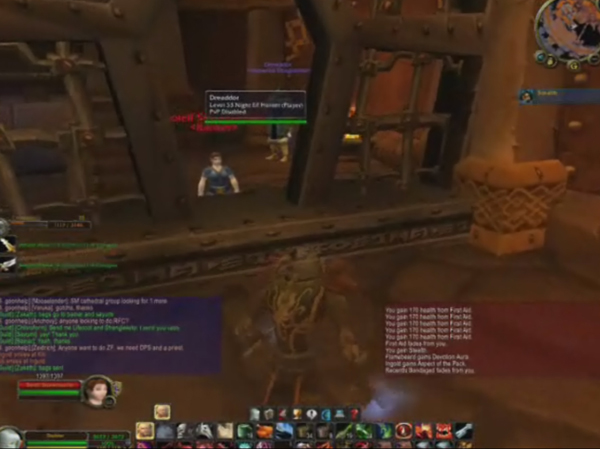
As a dramatic and sinister deed, Daddar’s massacre of the Ironforge bankers ranks with the assassination of Lord British by the thief Rainz during the beta of Ultima Online, a similar feat of slaying someone who had been viewed until then as invincible. Firmly in the tradition of PvP replays, Daddar’s video also demonstrated the arrival of WoW movies as a central focus of the game and fan culture growing up around the game, by then clearly destined to set new standards for massively multiplayer roleplaying games in terms of both sales and popularity. One player summarized a sentiment echoed hundreds of times in forums and discussion boards, “A level 60 rogue from the Goon Squad snuck into the Ironforge bank a number of times and assassinated the bankers. Except for the first time, he made it out alive on the other attempts. I thought the video was cool as Hell. It's the little cool things like this that make the game worth playing.” [14] Other players were inspired by the movie to create similar Undead Rogue characters: “Very awesome!!! Rogue is my favorite class and now i'm 100% sure to play Undead Rogue in retail.. gotta love that epic mount as well ... beautiful!!” or “Never imagined it would be this cool, actually... Makes me wanna go rogue for retail.” [15]
While disconnected from the performances of technical mastery characteristic of other virtual communities, Daddar’s movie is reminiscent of the significance of exploits, some taken to the edge of criminal behavior, for hacker clans and in multiplayer games such as Diablo. [16] At the same time, while the visual flow, music and homage paid to stock cinema scenes such as the getaway could be appreciated in a general sense by almost anyone, full appreciation of Daddar’s daring deed required inside knowledge of the game, as evidenced by discussion in the player community of the weapons and abilities used, or whether one should be impressed by the degree of skill actually required to defeat non-player characters of a much lower level than his. Players imitated the feat, testing out and comparing their own skills against this now legendary, if shadowy figure become part of the player community’s shared history. Through these discussion threads and commentary, the spectacle of Daddar’s video gradually mutated into a thoroughly documented moment from the history of a virtual world, not the fictional world of Azeroth, but its player-created counterpart.
Pals for Life & Leeroy Jenkins
“Leeroy. n.1: One who does not grasp the concept of caution.
2: One whose success is based purely off relentless aggression and pure luck.
3: One who likes chicken.
4: One whose battle cry consists of their own name.”
- Urban Dictionary

If there is one icon of the WoW player, one movie from the game that everyone has seen, it is without a doubt “Leeroy Jenkins.” It has been popular enough to leave traces throughout web-based popular culture and virtual media, from viral video sites to a storefront with Leeroy merchandise at cafepress.com, even in sly references found in comics and other computer games. [17] Created in May 2005 by the notoriously quirky Pals for Life guild on the Bloodhoof server, it has since been downloaded more than a million times on the Warcraftmovies site alone, while also being distributed via Fileplanet, Gamespot’s DLX service, Xfire, ifilm and other video servers. The video begins as Leeroy’s guild-mates prepare for a run at the Rookery Room. Leeroy’s in-game character avatar sits off to the side in a manner that suggests that he is not paying attention, most likely “away from keyboard” (AFK). This run is hardly easy pickings; it is part of a difficult raid set in the Upper Black Rock Spire instance that leads eventually to the legendary Onyxia quest, a dragon so challenging that movies are routinely made to document the prowess of the guilds that have defeated it. As the other Pals for Life players ponder strategy and carefully calculate their odds for success, Leeroy suddenly wakens from his stupor and recklessly charges into the Rookery, screaming his name as a war cry. Caught off-guard, the party dashes in to help Leeroy, but is quickly and mercilessly massacred. Berated by his guild-mates for his impossibly incompetent performance, Leeroy reveals the reason for his lack of attention, “at least I have chicken.”
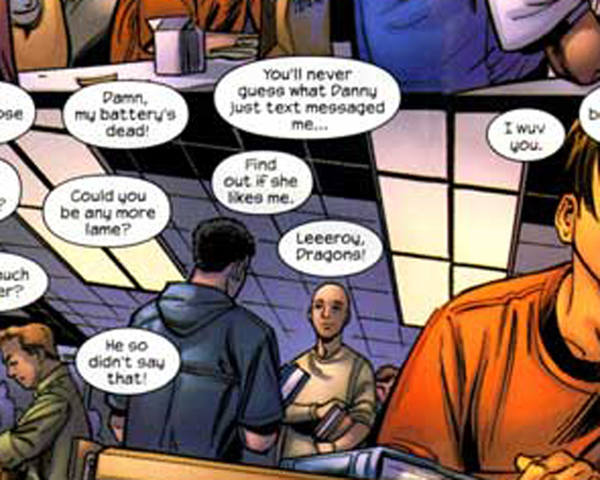
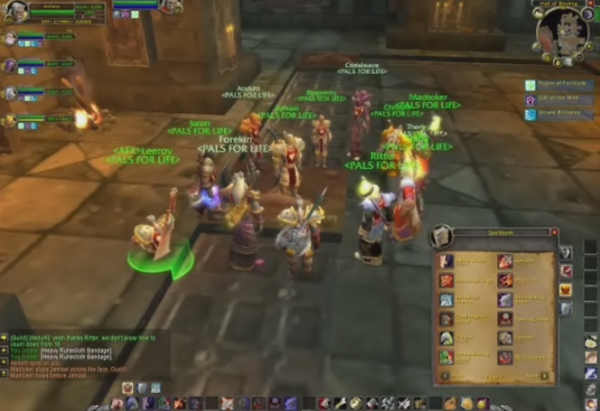
In short, Leeroy Jenkins is the anti-Daddar. And yet, the sheer incompetence of his gameplay requires the viewer to grasp intricacies of the game such as the location, enemies, and strategies cited. Despite the popularity of the movie and its success in breaking out beyond the World of Warcraft community, it is difficult for non-players to grasp this situation beyond the absurdity of Leeroy’s witless charge. As with Daddar’s exploit, the player community has largely focused on issues of authenticity in “Leeroy Jenkins”, debating whether the incident was a genuine failure or merely staged by Pals for Life for the video recording. As a performance, “Leeroy Jenkins” comments on a moment – death by incompetent playing partner – experienced by players of almost any multiplayer game. Whether or not this particular failure happened or not is irrelevant. It thus overcomes the specificity of gameplay through an interplay of images and dialog that creates a more general reference, a comedy of spectacular failure—in short, an anti-replay. Other Pals for Life movies, such as the mock battle in “Anfrony vs. the Giant Baile” and the marvelous “sky cam” shots in “Freefalling,” also occupy this liminal space between documented gameplay and fictional performance, mixing gimmicky characters and actions with an emphasis on exploits and use of musical accompaniment familiar from dozens of other movies. The validity of “Leeroy Jenkins” draws in a conventionally theatrical way upon the universality of what is depicted, rather than its specific truth; like Daddar’s movie it suggests how game-based performance can tell stories based on the shared culture of player experiences, but also suggests how such movies can circulate beyond the player community.
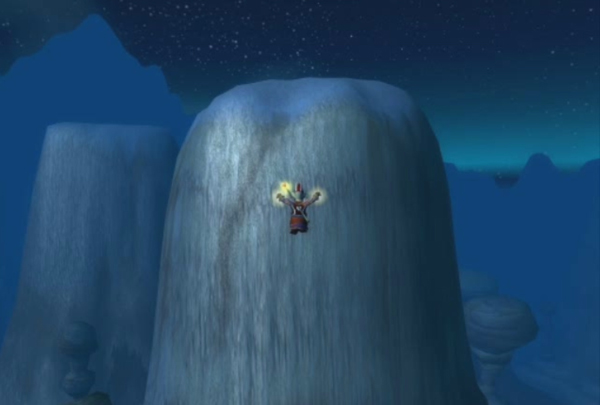
Tristan Pope’s “Not Just Another Love Story”
“I only executed what the pixels in WoW suggest …”
- Tristan Pope, Crafting Worlds website
Paul Marino of the Academy of Machinima Arts and Sciences has defined machinima as "animated filmmaking within a real-time virtual 3D environment." Nothing in this definition requires modification of a game's artistic assets or the creation of new artwork, or any particular approach to narrative or movie-making. In his guide to The Art of Machinima, Marino describes 3D game technology as the "interactive space" within which the machinima filmmaker operates, rather than as a realm of technology that he must master. [18] Little attention has been given to the potential for creative conflict beneath the surface of the relationship between machinima and game developers. Nearly a decade after the first Quake movies, "mature" machinima working with established tools and accessible game technology such as offered by 3-D first-person shooter games can side-step this issue to some extent by modifying or creating new intellectual property for their productions. The game engine really does remain "under the hood;" in the case of projects such as Fountainhead Entertainment's "Anna," viewers hardly notice that they are made with game technology. Machinima artists working within the server-based environments of massively multiplayer games do not have the same freedom in divorcing the characters and images of their works from game assets and intellectual property (I.P.). Moreover, MMO-based movies are created within a social as well as an interactive environment. The creators of WoW movies find that their work is constrained by technical limitations and complicated by the social dynamics of the game communities.
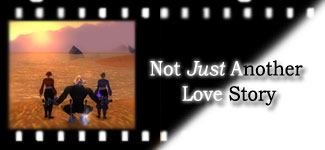
Tristan Pope's "Not Just Another Love Story" provides a case study of the issues faced by machinima artists who seek to sharpen the edges of MMO-based “story-line” movies. A theater student from the City College of New York and co-founder of the Raiders of Goldshire clan on the Lightning’s Blade server, Pope released his first WoW movie, "I Surrender," near the end of the beta period. Completed after playing WoW for only three days, he was inspired by other beta period dance and party movies available around that time, such as Jace’s “Jace in the World of Warcraft” and probably Masse’s “Stress Test Party”. [19] He created the Crafting Worlds website to facilitate the distribution of his projects to the WoW community. With each of his movies from "I Surrender," released in November 2004, through "Onyxia Eliminated," completed in April 2005, he worked through remediations of various movie and even game replay formats, such as the music video, sketch comedy, and guild demo. In April, he coyly introduced a more ambitious project, "Not Just Another Love Story”:
"I want to give you a full description of this movie, but that would ruin the surprise.
I'll give you a hint: I only executed what the pixels in WoW suggest …
And it has something to do with something that was removed in patch 1.3.
Ok, that's all you get!" [20]
Beginning with the disclaimer that “this movie contains material that may not be suitable for all ages,” Pope tells a Romeo-and-Juliet story, but with a game-specific twist. It sets up the story by showing his Troll Rogue character, Tristanmon, heading off to work in the desert and settling into another day of creature kills. In the middle of combat, he falls head over heals in love with a human female who can match him kill for kill. Alliance and Horde characters do not mix in this world, but despite such taboos, they become engaged and marry. Pope uses editing, character positioning, and carefully chosen camera angles to depict the pair consummating their love in various ways. The highlight of Pope’s movie is a spectacular rave during which the Troll emerges from his shell and is fully transformed by love into a wildly dancing party animal. The masterfully choreographed series of scenes would not have been possible without dozens of player-actors, choreographed actions and spell effects, cleverly chosen locations, and immense pre-production planning. In a stunning reversal, the troll’s new life is shattered after the party by the death of his spouse in combat, but his luck holds out when she is resurrected by an equally attractive human female, thus providing the basis for this threesome to live happily ever after.
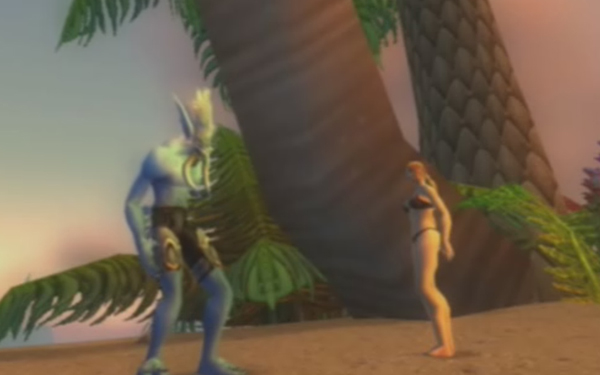
This plot summary of “Just Another Love Story” fails to reveal how Pope purposefully sharpened the narrative edge of game-based performance to give voice to the player community, a crucial characteristic of meaningful fan-created content. [21] The content, visual tactics and subsequent audience reaction to the video activated several neuralgic points for the participatory culture of WoW moviemaking. The story provoked attention to issues of creative ownership of the story world. Since the first Warcraft game, subtitled “Orcs vs. Humans,” the narrative momentum pushing forward the single-player campaign was faction and racial hatred. While the opposed races and their relative moral elevation could be remixed from version to version of the game (such as the focus on the reawakened nobility in the Orcs of Warcraft III), the role of relentless and unremitting conflict in shaping the history of the fictive world remained constant and fundamental. As players descended from the strategic perspective of the RTS games to play on the ground in World of Warcraft, they discovered that these conflicts had been built into their characters. This fundamental fact of Warcraft life translated into the inability of Horde and Alliance characters to communicate directly in-game through language. Chat was impossible, and shouted speech was rendered as unintelligible gibberish; the game software even recognized and filtered out subversive attempts to communicate by embedding text in descriptive gestures, known as “emotes”.
Beginning in the beta version of the game, players discovered that the language of computing and game culture provided the key for unlocking a system of universal speech. Just as an earlier generation of hackers and gamers had used it to circumvent mail and bulletin board language controls, they found that it was possible to bypass Blizzard’s text filters by embedding the number- and special character-based misspellings of “1337 speak” (“leetspeak,” or elite speak) in emotes, making it possible for, say, trolls to speak with their human enemies. This was a clear transgression of Blizzard’s control of the relationship between gameplay and story world, so in the 1.3 patch of the game the development team announced that henceforth “numbers and punctuation will not be passed through chat communication to members of the opposing faction.” [22] In the context of this assertion of Blizzard’s control, Pope’s depiction of the marriage of Troll and Human characters, as well as the massive collaboration of Horde and Alliance players evident in the movie itself, represented an alternative vision of the game world favored by some players. In the movie, Pope directed a final comment to Blizzard after the credits had wound down and the waning notes of The Darkness’ “I Believe in a Thing Called Love” had faded away: “Even without leet speak you cannot take away our love!” The mature content creatively constructed through character positions and camera angles in the video intensified this point, but it also sharpened the ensuing controversy. Machinima based on massively multiplayer games are inherently constrained by lack of access to the artistic assets of the game, in sharp contrast to readily modified games such as first-person shooters. But an often overlooked implication of this restriction is, as Pope argued with a wink, that he had merely showed “what WoW’s pixels imply ?.” Even sexual imagery, therefore, was nothing more than a rearrangement of what Blizzard’s artists had drawn, or more accurately, what its game engine generated during gameplay. Rather than asserting his right to subvert the game’s content, Pope turned this argument on its head by reasoning that he had in fact created nothing.
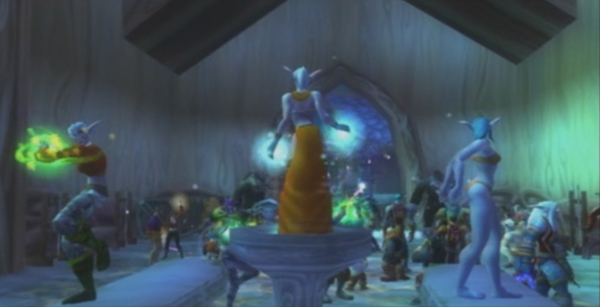
Blizzard, ever eager to support the player community, has sponsored WoW events such screenshot and stunt competitions. Community managers encourage announcements about new game movies in official WoW forums, allowing creators to provide links to facilitate downloading of video files. Initially, Pope was allowed to post such a link, but within two days the volume of complaints, flames, and counter-flames about “adult” scenes in “Not Just Another Love Story” caused Blizzard to cite the user agreement concerning language or images that are “pornographic in nature” and lock the discussion thread. It also barred links to any of the movie’s download sites in subsequent discussion threads. [23] The marketing of in-game creativity had collided head-on with the game’s demographics and success, which by then had brought many young players to the WoW player community. Players responded with arguments such as, "How can making an IN GAME movie with only IN GAME animations, on a forum about THAT GAME be inappropriate?" or took Blizzard’s side, “Let me go take Ken and Barbie at Toys R Us and pose them in sexual ways, and say ‘But whoamygod~ their joints BEND that way so its not sexually suggestive or inappropriate for us to advertise that way!!!’ Plus you're overlooking the simple fact that there ARE forum rules prohibiting these things.” [24] Pope conceded Blizzard’s right to some measure of control, but questioned why it would renege on earlier support for his movie-making project: "I understand that the forums and the game are not run by the Constitution, but there needs to be a finer line IMO between that and this. I do not want anarchy, but I also don't want censorship over something that took what is already in game and just made it more provocative." [25] Before the controversy ran out, two discussion threads devoted to it had garnered nearly 800 replies and more than 200,000 views. [26] By acting as a lightning-rod for commentary on the contested boundary between developer and player control of a complex, multiplayer game world, Pope’s “Not Just Another Love Story” demonstrated that game movies could function as a medium for public discussion and negotiation of issues important to the player community.
While it is tempting to read the chronological sequence of these four WoW movie projects as suggesting that MMO-based machinima may break out of player culture to engage with more challenging stories and themes, a sample of four projects representing barely 1% of the movies collected by Warcraftmovies.com alone hardly constitutes a complete history of this media phenomenon. It is clear even from such a preliminary survey, however, that player-created game movies have provided the largest player community ever assembled for a massively multiplayer game with a popular and important outlet for creative expression and performance. I would like to conclude by suggesting that further work is needed on the specific contribution of game-based movies both as public performances and as media objects to the formation and continuation of player communities. Whether as creator, performer, collector, enunciator or spectator, the massive participation of players in the creation of a game-based medium deserves our careful attention. [27]
Endnotes [
back ]
[1. On the history of machinima: Henry Lowood, "High-Performance
Play: The Making of Machinima." To appear in: Videogames and
Art: Intersections and Interactions , ed. Andy Clarke and Grethe
Mitchell (eds.) (Intellect Books: 2005); Henry Lowood, "Real-Time
Performance: Machinima and Game Studies," The International Digital
Media and Arts Association Journal 1, no. 3 (Spring 2005): 10-17;
Michael Nitsche, “Film Live: An Excursion into Machinima”
in: Developing Interactive Narrative Content: sagas_sagasnet_reader,
ed. Brunhild Bushoff (Munich: High Text, 2005): 210-243]
[2. Henry Jenkins, “’Strangers No More, We Sing’: Filking and the Social Construction of the Science Fiction Fan Community,” pp. 208-236 in: Lisa A. Lewis, ed., The Adoring Audience: Fan Culture and Popular Media (London and New York: Routledge, 1992): 208. See also his Textual Poachers: Television Fans and Participatory Culture (London and New York: Routledge, 1992).]
[2a. Henry Lowood, “It’s Not Easy Being Green”: Real-Time Game Performance in Warcraft." To appear in: Videogame/Player/Text, eds. Barry Atkins and Tanya Krzywinska. (Manchester Univ. Press, exp. 2006).]
[3. Dani Bunten Berry, “Game design memoir.” (n.d.) Retrieved March 2005 from Dani Bunten Berry memorial site at http://www.anticlockwise.com/dani/personal/biz/memoir.htm]
[4. id Software, Corporate Website (20 Dec. 1996), retrieved June 2003 from the Internet Archive at 19961220085757/www.idsoftware.com/clans/index.html]
[5] K. Tam, “Warcraft 3 Reigns [sic] of Chaos F.A.Q & Walkthrough for Warcraft 3 on PC” (3 March 2003). Online version 1.81 retrieved March 2005 from http://db.gamefaqs.com/computer/doswin/file/warcraft_iii.txt]
[6. The few exceptions may be seen as proving the rule, in that they
have been produced not for player communities, but for other audiences,
such as the 4-minute “supplies and teh man” short in episode
4 of Pure Pwnage, based on the Zero Hour expansion of Command & Conquer:
Generals, the use of Rome: Total War in the BBC’s “Time Commanders”
television series, or even the game-based cinematics used by Blizzard
in some Warcraft III cutscenes and credits.]
[7. The discussion board of the site opened on 29 Sept. 2004. The Internet
Archive first captured the site on 9 Oct. 2004. Uzbeki, the administrator
of the site, began to send out announcements to message boards at the
beginning of the month, e.g., to the WoW Public Forum on Universal Realms,
"New: WoW movies site," 2 Oct. 2004, retrieved Sept. 2005 from
Google's cache of http://www.universalrealms.com/ShowPost.aspx?PostID=565;
Uzbeki, "subject: first =)", posted 4 Oct. 2004, retrieved Sept.
2005 from http://warcraftmovies.com/forum/viewtopic.php?p=6&highlight=#6]
[8] On the history of the Warcraft series, see: Henry Lowood, “It’s Not Easy Being Green”: Real-Time Game Performance in Warcraft." To appear in: Videogame/Player/Text, eds. Barry Atkins and Tanya Krzywinska. (Manchester Univ. Press, exp. 2006)]
[9. Mute, “The World of Roguecraft – Episode 3” (August 2005)]
[10. E-mail from Laura "BahdKo" Herrmann to Henry Lowood (28 Jan. 2004)]
[11. “Welcome to the DOOM Honorific Titles!,” DOOM Honorofic Titles website. URL: http://www-lce.eng.cam.ac.uk/~fms27/dht/dht5/#dht5]
[12.United Canadian Alliance website, retrieved Sept. 2005 from http://clanuca.ca/index.php?content=about&PHPSESSID=2383368b5ff886e3c04ba1f0f1baab7c>]
[13. One popular example is Bain Street Productions’ "Dance
Voldo, Dance" (1992), made in Soul Caliber. Bain Street Productions
website, retrieved Sept. 2005 at http://www.bainst.com/madness/voldo.html
]
[14. Monkey, “Ironforge Pwnage,” post dated 19 Jan. 2005 on the Cataclysm Forum, retrieved January 2005 from http://66.102.7.104/search?q=cache:gQkEnkYzDjUJ:www.phu-q.org/cataclysm/forum/viewtopic.php%3Ft%3D75%26sid%3Dd045346277625a0bb56bfd4f7254d63b+%22ironforge+bank%22+goon&hl=en]
[15. Redrum, post dated 17 Jan. 2005 to Warcraftmovies forum, retrieved Sept. 2005 from http://www.warcraftmovies.com/movieview.php?id=296; Reffee, post dated 9 Feb. 2005 to Warcraftmovies forum, retrieved Sept. 2005 from http://www.warcraftmovies.com/movieview.php?id=296. Several Stanford students have told me that they “rerolled” Undead Rogues after seeing this movie for the first time.]
[16. Cf. Douglas Thomas, Hacker Culture (Minneapolis: Univ. of Minnesota Press, 2002); Andy Kuo, “A (Very) Brief History of Cheating,” STS 145 Papers Collection, retrieved Sept. 2005 at http://sul-dl-dlib2.stanford.edu/gsdl/collect/sts145/index/assoc/HASHfe5f.dir/doc.pdf]
[17. A character refers to “Leeeroy Dragons,” in Ultimate Spider-Man #81, Aug. 2005, while a character in Guild Wars named Kilroy Stoneskin yells his name while attracting the ire of every monster in sight.]
[18. Paul Marino, 3D Game-Based Filmmaking: The Art of Machinima (Scottsdale: Paraglyph, 2004): 2-3]
[19. Information about Pope and his movies at the Crafting Worlds website, retrieved February to Sept. 2005 at http://www.craftingworlds.com/, and "Interview with The Godfather," WarcraftMovies website, retrieved Feb. 2005 from http:www.warcraftmovies.com.]
[20] "Videos," Crafting Worlds website, retrieved April 2005 from http://www.craftingworlds.com/videos.html.]
[21. Cf. Henry Jenkins, Textual Poachers]
[22. World of Warcraft 1.3 patch notes, retrieved May 2005 from http://www.worldofwarcraft.com/patchnotes/patch-05-07-04.html]
[23. See: Caydiem, "Subject: Re: Rated M for Mature: LOCKED Was a good run!," posted 22 April 2005 to World of Warcraft General Discussion Forum, retrieved May 2005 from http://forums.worldofwarcraft.com/]
[24. As argued in three posts by Necrotus,"Subject: Re: Rated M for Mature …," all posted 22 April 2005 to World of Warcraft General Discussion Forum, retrieved May 2005 from http://forums.worldofwarcraft.com/. Response by Fairon, dated 23 April 2005.]
[25. Tristanmon, "Subject: Rated M for Mature … ," posted 22 April 2005 to World of Warcraft General Discussion Forum, retrieved May 2005 from http://forums.worldofwarcraft.com/]
[26. Crafting Worlds website, post dated 18 April 2005 by Tristan Pope retrieved May 2005 from http://www.craftingworlds.com/videos.html]
[27. Important leads in this investigation will be provided by Howard Becker’s notion of “art worlds” as a “collective activity;” by John Fiske’s “cultural economy of fandom;” and perhaps by Victor Turner’s concept of the “social drama” as a performance space. See Howard S. Becker, Art Worlds (Berkeley and Los Angeles: Univ. of California Press, 1982); John Fiske, “The Cultural Economy of Fandom,” pp. 30-49 in: Lisa L. Lewis, ed., The Adoring Audience: Fan Culture and Popular Media (London: Routledge, 1992); Victor Turner, The Anthropology of Performance (New York: PAJ, 1986).